Food blogging continues to stand out as one of the most profitable niches in the content creation space. The right WordPress theme can make all the difference between a successful food blog that attracts readers and monetizes effectively versus one that struggles to gain traction. As we help clients build effective websites across industries, we’ve seen firsthand how specialty themes can transform the user experience for specific niches.
Food blogs have unique requirements that general-purpose themes often can’t address effectively. From recipe cards and ingredient lists to food photography galleries and structured data for search engines, food blogs need specific features to truly shine. Choosing the right theme isn’t just about aesthetics – it’s about creating a foundation for your content to reach its maximum potential.
In this guide, we’ll explore the best WordPress themes specifically designed for food blogs in 2025. We’ll cover both free and premium options, highlight key features to look for, and provide clear guidance on selecting the perfect theme for your culinary content. Whether you’re just starting your food blog journey or looking to upgrade your existing site, this guide will help you make an informed decision.
Why Your Food Blog Needs a Specialized WordPress Theme
Food blogs have specific needs that general WordPress themes simply don’t address adequately. While any theme can display text and images, food blogs require specialized functionality to effectively showcase recipes, cooking techniques, and food photography. Using a theme designed specifically for food blogs gives you access to features that enhance both user experience and search engine visibility.
Recipe-focused themes include built-in recipe card formats that organize ingredients, instructions, cooking times, and nutritional information in a way that’s both visually appealing and functional. These structured formats also implement proper schema markup, which helps search engines understand and feature your content in recipe search results. Food blogs with structured recipes appear in 40% more search snippets than those without proper formatting. (Source: Bluehost)
Additionally, food blog themes typically feature optimized image galleries and sliders that showcase your culinary creations in their best light. They often include specialized layouts for different content types, such as recipe collections, cooking guides, and restaurant reviews. These purpose-built features create a more engaging experience for your readers while simplifying the content creation process for you.
Another compelling reason to choose a food-specific theme is monetization optimization. Food blogs have unique monetization opportunities through recipe sponsorships, cookbook promotions, and cooking tool affiliates. Specialized themes often include widget areas and promotional spaces designed with these revenue streams in mind, making it easier to integrate monetization elements naturally within your content.
Key Features to Look for in a Food Blog WordPress Theme
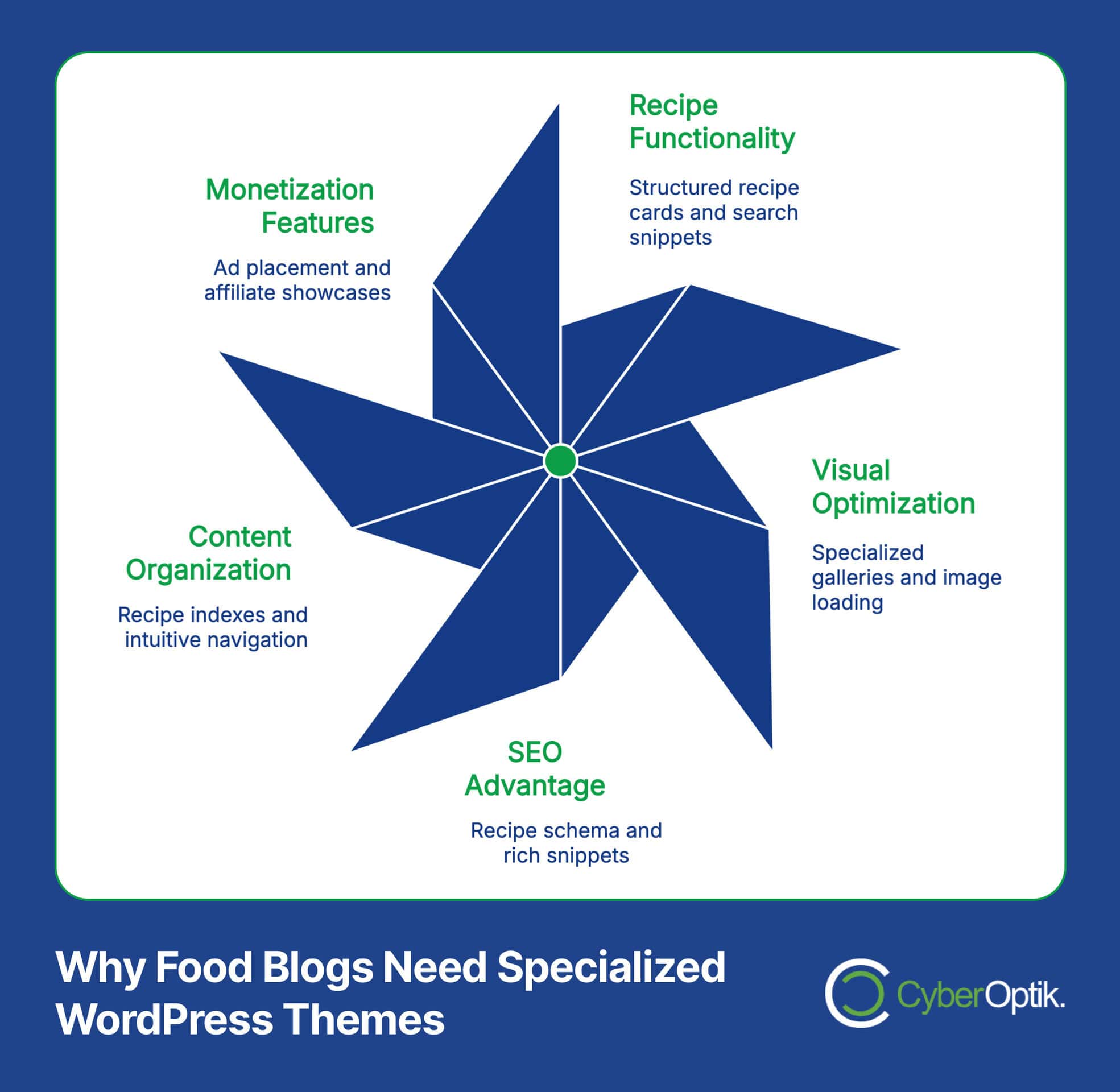
When selecting a WordPress theme for your food blog, certain features are essential for success. Understanding these key elements helps you evaluate themes based on your specific needs rather than just appearance. Here’s what truly matters in a food blog theme:
Essential Food Blog Theme Features
Before diving into specific themes, let’s examine the crucial features that make a WordPress theme suitable for food blogging. These elements significantly impact both user experience and your blog’s performance in search results.
The table below ranks these features by importance, providing a framework for evaluating potential themes:
| Feature | Importance (1-10) | Impact on User Experience | Impact on SEO |
|---|---|---|---|
| Recipe Card Functionality | 10 | High - Creates structured, easy-to-follow recipes | High - Enables rich snippets in search results |
| Schema Markup Support | 9 | Medium - Invisible to users | Very High - Critical for recipe search visibility |
| Mobile Responsiveness | 9 | Very High - Essential for kitchen use | High - Mobile-first indexing is standard |
| Image Optimization | 8 | High - Food photography is crucial | Medium - Affects page speed |
| Print-Friendly Recipes | 7 | High - Enhances usability | Low - Minimal direct SEO impact |
| Category Organization | 6 | Medium - Helps content discovery | Medium - Improves site structure |
| Pinterest Integration | 6 | Medium - Facilitates social sharing | Low - Indirect traffic benefits |

Recipe card functionality stands as the most crucial feature for food blog themes. Good recipe cards display ingredients, instructions, cooking times, and nutritional information in a structured, easy-to-follow format. They should include features like adjustable serving sizes, printable options, and visual elements like prep time icons.
Schema markup support works hand-in-hand with recipe cards, adding invisible code that helps search engines understand and feature your recipes in search results. This structured data can significantly improve your visibility in Google’s recipe carousel and featured snippets.
Mobile responsiveness carries particular importance for food blogs, as many readers use their devices while cooking. A good food blog theme should look great and function perfectly on smartphones and tablets, with easy-to-read recipe text and simplified navigation for kitchen use.
Image optimization features are essential since food blogging is highly visual. Look for themes with gallery options, image optimization, and layouts that showcase your food photography effectively. Speed optimization for images is also crucial, as large, unoptimized food photos can slow down your site considerably.
Top Free WordPress Themes for Food Blogs
Free WordPress themes offer an excellent starting point for new food bloggers or those on a tight budget. While they may have fewer features than premium options, several free themes provide everything needed to create a successful food blog. Here are the top free WordPress themes specifically designed for food blogs in 2025:
Astra
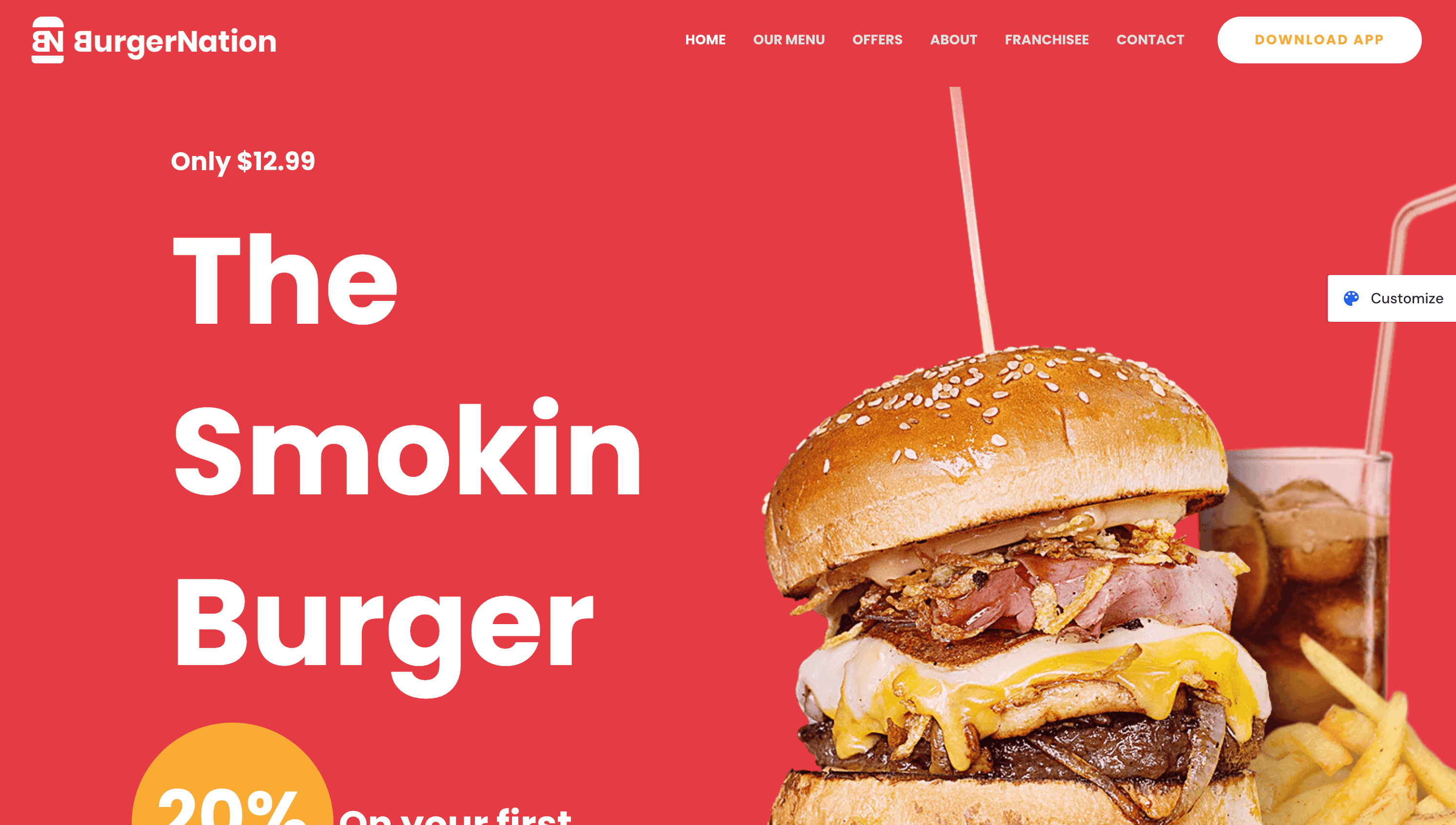
Astra stands out as one of the most versatile free WordPress themes, with specific advantages for food bloggers. With over 2.4 million active installations, it’s a widely trusted option with extensive community support. (Source: CyberChimps)
This lightweight theme delivers exceptional speed performance, which is crucial for user experience and search rankings. While the free version includes essential features, the Pro version adds valuable food blog enhancements including recipe schema markup for better search visibility.
Astra’s strengths include its clean design, extensive customization options through the WordPress Customizer, and compatibility with popular page builders like Elementor and Beaver Builder. The theme’s modular approach lets you enable only the features you need, keeping your site lean and fast.
For food bloggers, Astra offers several specialized demo sites that can be imported with a single click, providing a solid foundation for your culinary website. Its flexible header and footer options give you control over your site’s navigation and branding elements.
Foodica Lite
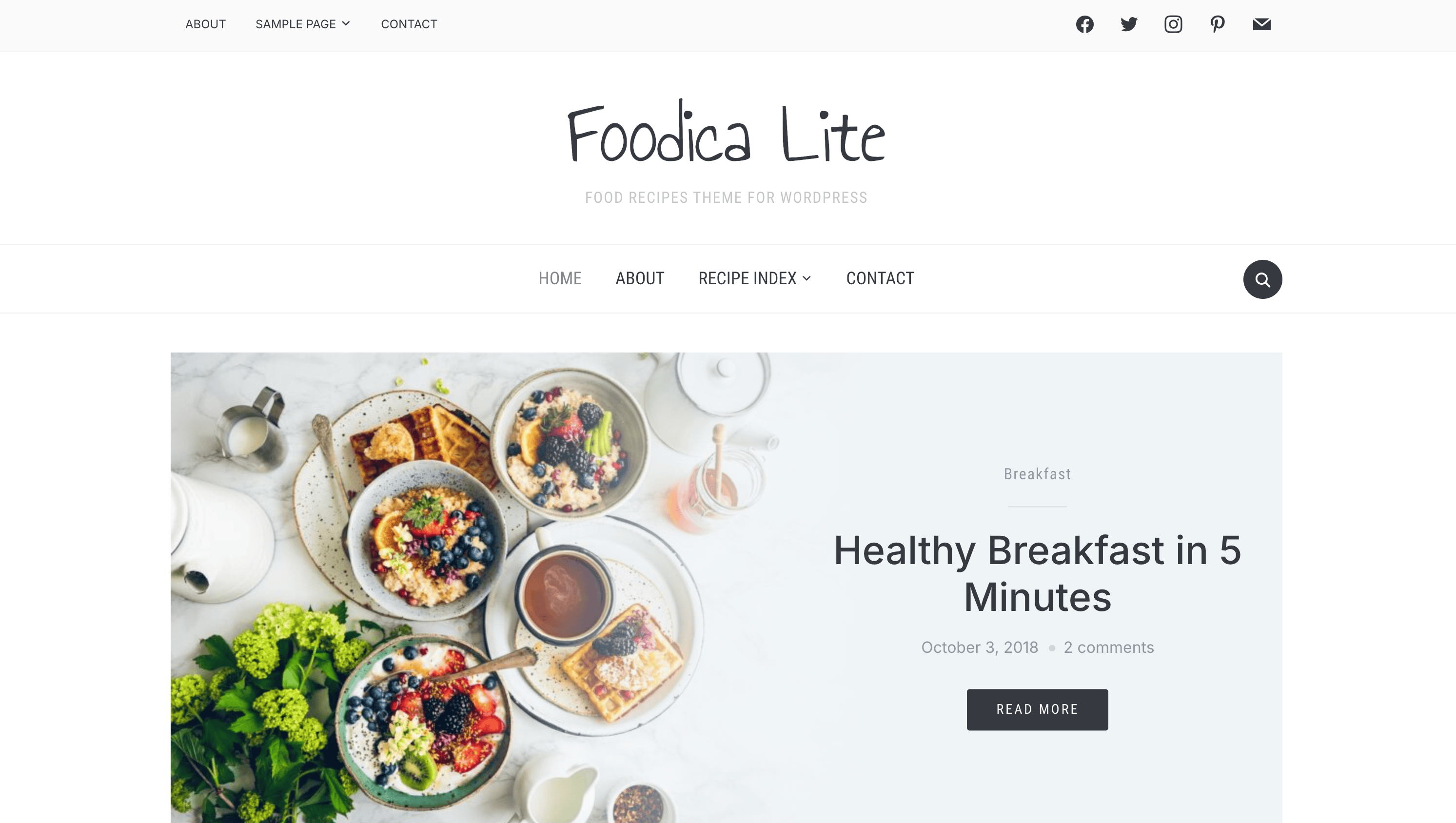
Foodica Lite is specifically designed for food blogs, with a clean, magazine-style layout that showcases recipes and food content beautifully. This theme strikes an excellent balance between aesthetics and functionality, with features tailored to food bloggers’ needs.
The theme includes multiple content layouts, featured post sliders, and customizable widget areas that help highlight your best recipes and content. Its clean design puts the focus on your food photography while maintaining good readability for recipes and posts.
What makes Foodica particularly valuable for serious food bloggers is its built-in ad placement options. This is especially important considering that 72% of food bloggers earning over $2,000 monthly use premium ad networks like Mediavine or AdThrive. (Source: Greedy Girl Gourmet)
Foodica Lite’s strengths include its food-focused design elements, responsive layout, and compatibility with recipe plugins. It also offers good performance metrics out of the box, with minimal bloat to slow down your site.
Kale

Kale is a free WordPress theme specifically created for food blogs, with a clean and minimalist design that puts your content front and center. Its simplified approach makes it particularly suitable for beginners or those who prefer a streamlined aesthetic.
This theme features a prominent featured content slider, recipe index templates, and customizable widget areas in strategic locations. Its built-in social sharing options help promote your content across platforms popular with food enthusiasts.
Kale’s design philosophy emphasizes readability and content hierarchy, making it easy for visitors to navigate your recipes and articles. The theme is also fully responsive, ensuring your food content looks great on all devices.
For monetization, Kale includes thoughtfully placed advertisement widgets – an important consideration given that 44% of food blog income typically comes from display ads. (Source: Small Biz Genius)
Comparing Free Food Blog Themes
To help you make an informed decision, we’ve compiled a detailed comparison of these free WordPress themes for food blogs:
| Theme | Best For | Recipe Features | Mobile Performance | Customization Level |
|---|---|---|---|---|
| Astra | Versatility & growth potential | Requires plugins | Excellent | Very High |
| Foodica Lite | Ad-focused monetization | Basic integration | Good | Medium |
| Kale | Beginners & minimalists | Basic templates | Good | Low-Medium |
This comparison highlights the different strengths of each free theme. Astra offers the most flexibility and customization options, making it ideal for bloggers who plan to expand their site over time. Foodica Lite excels at ad placement and content organization, perfect for monetization-focused bloggers. Kale provides the simplest experience with food-specific features built in, making it ideal for beginners.
Premium WordPress Themes Worth the Investment
While free themes offer a good starting point, premium WordPress themes provide advanced features, dedicated support, and specialized functionality that can significantly enhance your food blog. For serious food bloggers looking to maximize their success, these premium themes offer exceptional value. Let’s explore the top premium WordPress themes for food blogs in 2025:
Foodie Pro

Foodie Pro has established itself as one of the most popular premium themes specifically designed for food blogs. Built on the Genesis Framework, it combines elegant design with powerful functionality tailored to culinary content creators.
This theme features minimalist aesthetics with ample white space that makes your food photography stand out. Its clean typography and thoughtful layout create an upscale feel that appeals to discerning food enthusiasts. The theme includes multiple page templates, customizable widget areas, and extensive styling options to create a unique look.
Foodie Pro excels at content organization with its recipe index feature, allowing visitors to browse your recipes by category, ingredient, or course. This organizational structure is particularly valuable for food blogs, which tend to accumulate large recipe collections over time.
The theme’s popularity in the food blogging community isn’t surprising considering that food blogs typically have 4x more followers than blogs in other niches. (Source: Bloggers Passion)
Cookely
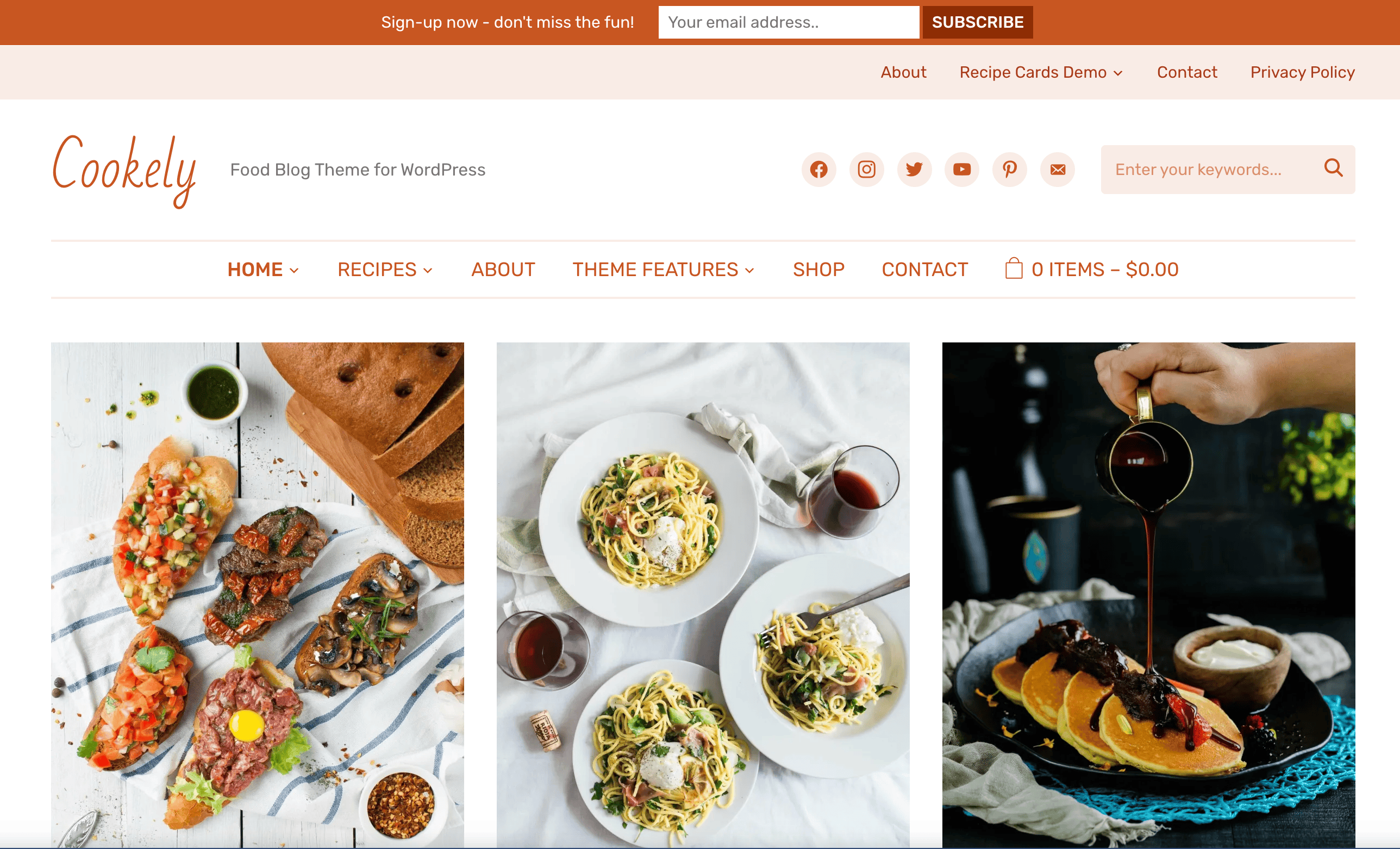
Cookely is a premium WordPress theme designed specifically for recipe blogs and food websites. Its standout feature is the deep integration with the block editor (Gutenberg), providing specialized recipe blocks and food-focused design elements right within the WordPress editor.
This theme includes built-in recipe card functionality with schema markup, eliminating the need for additional plugins. The recipe cards feature adjustable serving sizes, preparation times, nutrition facts, and ingredient checklists. These advanced recipe features can help maximize your earning potential – particularly important given that the median monthly income for food bloggers is $9,169. (Source: Starter Story)
Cookely’s design emphasizes visual content with multiple gallery styles, featured image treatments, and Instagram feed integration. The theme includes several demo sites that can be imported with a single click, providing various style options from minimalist to colorful layouts.
For monetization, Cookely includes strategic widget areas and promotion sections designed specifically for food blog revenue streams. Its WooCommerce compatibility also makes it easy to sell cookbooks, cooking tools, or digital products directly from your site.
Gourmet
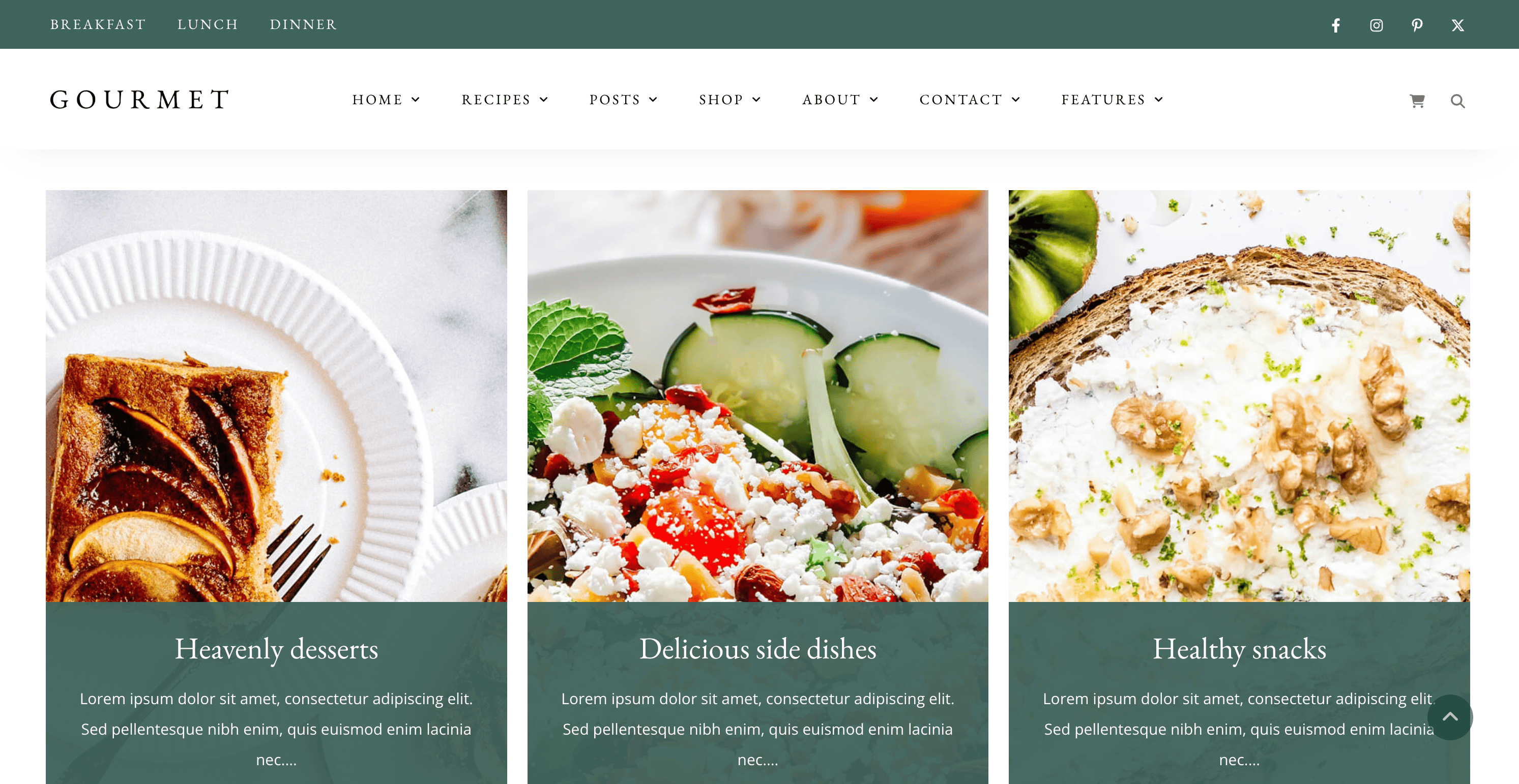
Gourmet is a premium WordPress theme that strikes an excellent balance between sophisticated design and practical functionality for food bloggers. Its visual approach prioritizes large, immersive food photography with layouts designed to showcase your culinary creations.
This theme includes specialized features for recipe bloggers, including custom recipe cards with schema markup, cooking time displays, and difficulty indicators. Its recipe index feature organizes your content into an attractive, filterable collection that helps visitors discover your recipes.
Gourmet’s design philosophy centers on creating a premium food magazine experience, with attention to typography, spacing, and visual hierarchy. This approach is particularly effective for blogs focusing on high-end cuisine or food photography.
The theme is optimized for search engines with clean code, fast loading times, and proper implementation of food-specific structured data. This SEO advantage is valuable considering that 42.8% of high-traffic blogs (over 50,000 monthly sessions) are food-focused. (Source: ScanWP)
Tasty Food
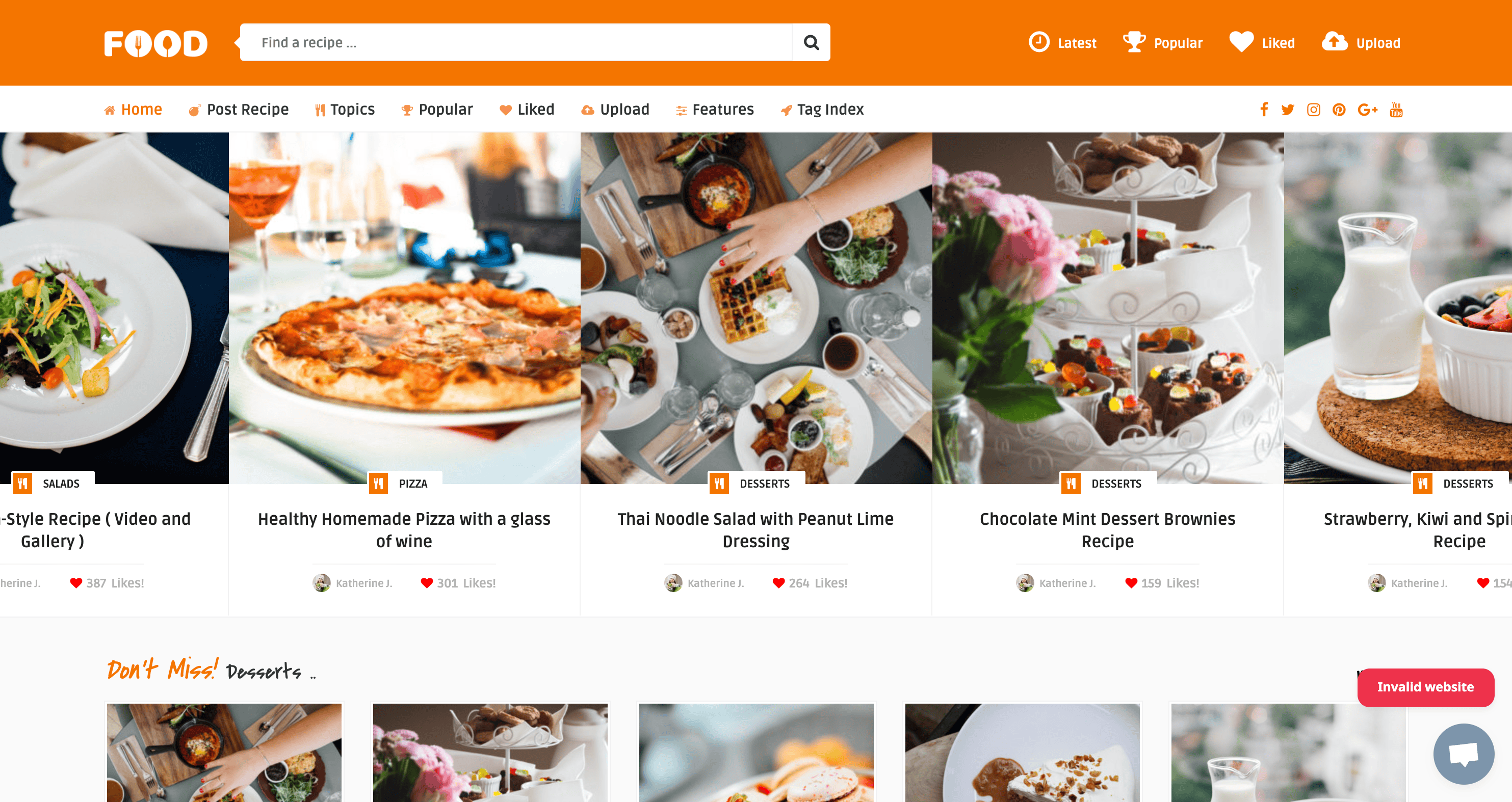
Tasty Food represents one of the newest and most innovative premium WordPress themes for food blogs. Released with the latest WordPress features in mind, it emphasizes performance, visual appeal, and integrated monetization options.
This theme features a modular design system using the Full Site Editing capabilities in WordPress. This approach gives you unprecedented control over every aspect of your site’s appearance without requiring coding knowledge. The theme includes multiple header and footer variants, customizable archive pages, and specialized recipe templates.
Tasty Food stands out for its comprehensive recipe functionality, including structured recipe cards with nutrition facts, ingredient scaling, and print options. The recipe display includes user-friendly features like jump-to-recipe buttons and ingredient checkbox lists for readers to track their progress.
The theme’s constant updates and improvements deliver significant benefits, as regular theme updates yield 270% more results for content creators. (Source: Ultida)
Premium Food Blog Theme Comparison
To help you evaluate which premium theme best suits your needs, here’s a detailed comparison of these top options:
| Premium Theme | Price Range | Built-in Recipe Cards | Design Style | Best For |
|---|---|---|---|---|
| Foodie Pro | $129.95 | No (requires plugin) | Minimalist, elegant | Established bloggers seeking refined aesthetics |
| Cookely | $69 | Yes (integrated) | Contemporary, versatile | Serious recipe creators |
| Gourmet | $89 | Yes (advanced) | Magazine-style, visual | Photography-focused food blogs |
| Tasty Food | $79 | Yes (comprehensive) | Modern, customizable | Tech-savvy bloggers wanting full control |
As this comparison shows, each premium theme offers distinct advantages. Foodie Pro provides elegant aesthetics with extensive customization. Cookely offers the best integrated recipe functionality. Gourmet excels for visually-oriented blogs with beautiful photography. Tasty Food provides the most cutting-edge WordPress features with excellent monetization options.
How to Choose the Right Food Blog Theme for Your Goals
Selecting the perfect WordPress theme for your food blog requires aligning your specific needs, technical abilities, and long-term goals with the available options. Here’s how to approach this important decision:
Consider Your Monetization Strategy
Your revenue model should heavily influence your theme choice. Different monetization strategies require different theme features and layouts:
| Monetization Method | Important Theme Features | Success Rate | Recommended Themes |
|---|---|---|---|
| Display Advertising | Strategic ad placements, content-dense layouts | High (44% of food blog income) | Foodica Lite, Tasty Food |
| Affiliate Marketing | Product showcase areas, review templates | Medium (22% of food blog income) | Cookely, Gourmet |
| Sponsored Content | Clean, brand-friendly design, featured content areas | Medium (16% of food blog income) | Foodie Pro, Astra |
| Digital Products | WooCommerce compatibility, landing page templates | Growing (12% of food blog income) | Astra, Tasty Food |
Blogs that focus primarily on ad revenue benefit from themes with strategic ad placements that don’t interfere with user experience. If affiliate marketing is your main strategy, look for themes with effective product showcase features and review templates. For selling digital products or courses, ensure your theme includes WooCommerce compatibility and sales-oriented page templates.
Understanding that blogs with 1000+ posts average $11,578 per month highlights the importance of choosing a theme that supports long-term content growth. (Source: Hostinger)
Assess Your Technical Skill Level
Your technical abilities should factor into your theme selection. Some themes offer simplicity at the expense of customization, while others provide extensive options that require a steeper learning curve:
- Beginners: Look for themes with one-click demo imports, visual customizers, and detailed documentation. Kale and Astra are excellent options for those new to WordPress.
- Intermediate Users: Themes like Foodica Lite and Cookely offer more customization without requiring code knowledge.
- Advanced Users: If you have design experience or development skills, themes like Foodie Pro and Tasty Food allow extensive customization through hooks, filters, and CSS.
Remember that custom WordPress website design can always be an option if you need a truly unique solution beyond what themes offer.
Evaluate Support and Updates
Theme support and regular updates are crucial for long-term success. Abandoned themes eventually develop compatibility issues with WordPress core updates, potentially causing security vulnerabilities or broken functionality.
Premium themes typically offer dedicated support channels with faster response times and more personalized assistance. Before purchasing, check:
- When was the theme last updated?
- What is the support policy? (duration, response time, support channels)
- What do customer reviews say about support quality?
- Is there a community forum or knowledge base?
Themes built on popular frameworks like Genesis (Foodie Pro) or with large user bases (Astra) typically enjoy longer support lifespans and more regular updates.
Optimizing Your Food Blog Theme for Success
Once you’ve selected the perfect WordPress theme for your food blog, optimization becomes the next priority. Even the best theme requires proper setup and configuration to achieve maximum performance. Here are essential optimization strategies for food blog themes:
SEO Best Practices for Food Blogs
Search engines highly favor WordPress sites with proper optimization. For food blogs specifically, these SEO practices deliver the best results:
- Implement Recipe Schema Properly: Ensure your recipe cards include complete schema markup with all fields filled out (ingredients, cook times, nutrition, etc.).
- Optimize Images: Food blogs are image-heavy, so compress and properly size all photos. Use descriptive file names and ALT text that include your target keywords.
- Create Content Clusters: Organize related recipes into topic clusters (e.g., all pasta recipes linking to a main pasta page) to strengthen topical authority.
- Use Descriptive URLs: Create SEO-friendly URLs that clearly describe the recipe, like “/creamy-garlic-parmesan-pasta/” rather than “/post-12345/”.
- Implement Internal Linking: Connect related recipes to each other using keyword-rich anchor text.
These practices work together with your theme’s built-in SEO features to improve search visibility.
Optimizing Load Times
Page speed significantly impacts both user experience and search rankings. Food blogs face particular challenges with load times due to numerous images and interactive elements.
AI-powered tools and features are increasingly important for food blogs, as AI-generated recipe variations have been shown to increase user engagement by 37%. (Source: One Hour Professor)
To maximize theme performance:
- Enable caching through plugins like WP Rocket or through your hosting provider
- Use a content delivery network (CDN) for images and static assets
- Minimize plugin usage to only essential tools
- Optimize your theme’s CSS and JavaScript loading
- Consider using next-generation image formats like WebP
If your theme includes performance optimization settings, take time to configure these properly. Many premium themes offer built-in options to defer non-critical JavaScript, lazy-load images, and minimize CSS – all of which improve page speed.
Mobile Optimization Tips
With most recipe searches happening on mobile devices, optimizing your food blog for smartphones and tablets is essential. Beyond choosing a responsive theme, consider these mobile optimization strategies:
Test your site on multiple devices to verify usability. Ensure recipe text is readable without zooming. Make ingredient lists and instructions easy to scroll through. Verify that all interactive elements (like recipe adjustments) work on touch screens. Position your “jump to recipe” button prominently for mobile users.
The benefits of WordPress as a CMS include excellent mobile customization options. Use WordPress’s mobile preview feature to check how your theme displays on different screen sizes.
Content Display Strategies
How you organize and display your content significantly impacts reader engagement and retention. For food blogs, these display strategies prove most effective:
Feature your most popular recipes prominently on your homepage. Create seasonal or themed content collections. Use visual previews with partial recipes to encourage clicks. Implement related recipes sections at the end of each post. Position your best food photography prominently in layouts.
The most successful food blogs make finding recipes intuitive through multiple navigation paths – categories, search, recipe indexes, and related content suggestions.
Conclusion
Selecting the right WordPress theme for your food blog is a crucial decision that impacts everything from user experience and visual appeal to search visibility and monetization potential. By understanding the unique requirements of food blogs and evaluating themes based on the specific features they offer, you can create a solid foundation for your culinary content.
Free themes like Astra, Foodica Lite, and Kale offer excellent starting points for new food bloggers, providing essential functionality without financial investment. For established food blogs or those with specific needs, premium themes like Foodie Pro, Cookely, Gourmet, and Tasty Food deliver advanced features and dedicated support that justify their cost.
Remember that the most successful food blogs combine great content with optimal technical implementation. Even the perfect theme requires proper configuration, ongoing maintenance, and strategic content planning to reach its full potential.
Common Food Blog Theme Mistakes to Avoid
As you implement your chosen theme, watch out for these frequent pitfalls:
- Overloading with plugins when your theme already includes the functionality
- Neglecting mobile optimization despite most recipe searches occurring on phones
- Focusing on aesthetics at the expense of usability and reading experience
- Ignoring SEO fundamentals like proper headers, image optimization, and schema
- Failing to customize your theme to match your unique brand and content style
By avoiding these mistakes and implementing the strategies outlined in this guide, you’ll be well-positioned to create a food blog that stands out in this competitive but rewarding niche.
We’ve helped numerous clients build successful WordPress websites across industries, and food blogs represent one of the most engaging and potentially profitable niches in content creation. Whether you’re just starting your food blogging journey or looking to take your existing site to the next level, the right WordPress theme provides the foundation for your success.
Now that you understand what makes a great food blog theme and which options best suit different needs, you’re ready to make an informed choice that aligns with your specific goals, content style, and technical requirements. Your perfect WordPress food blog theme awaits!
How do you choose the right web design company to help implement your food blog vision? Consider their WordPress expertise, previous work with food-related websites, and understanding of both technical needs and visual aesthetics for culinary content.




